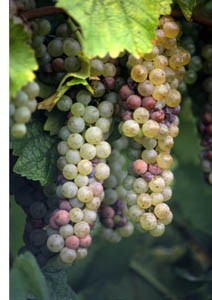Fine from the Vine: Late harvest grapes that have hung heavy and gathered sugars and mold (yum!) pair brilliantly with dinner.
Sweet ‘n’ Power
Dessert wines can make a rare match with the meal
By Richard Paul Hinkle
The most basic beverage postulate in this country is that Americans prefer their liquids light, cold and sweet. No shocker there, to be sure, from soda pop to mixed drinks.
No surprise, either, that the late harvest wines–those ambrosial beauties so often informed by the botrytis infection that adds a honeyed tone to the sugar high (and seriously concentrates both sugar and flavor by way of dehydration)–are most often served as dessert: by themselves, complemented with melon or contrasted with a sharp cheese like Roquefort.
Imagine my surprise, then, the first time I was served Sauternes–that immensely rich, sweet, high-alcohol (15 percent is the norm) French wine that is the very epitome of dessert–with roasted chicken. Not once, but three times in a week’s visit to that exquisite corner of Bordeaux! When they first poured the gold-colored, syrup-thick liquid into my wine glass–the chicken was already on my plate–I looked from one to the other, then looked out the nearest window searching for airborne oinkers. Not seeing any winged pigs, I tasted the chicken. Succulent, moist, juicy, like a slow-roasted chicken should be. Then I sipped the wine and, lo and behold, I got it! Wow!!
That’s the experience you want when any new food and wine combination really works. Wow!! With double exclamation marks. Wow!! It is not necessary to work out the logistics of it, if there be any. It is quite enough to do the double “Wow!!” and simply luxuriate in something so right, so sensual, so utterly uplifting.
Only after the experience has fully settled in, after it is sufficiently milked for that sensual satisfaction, do you allow yourself the minor luxury of analysis–why it worked so well–and the exploration for other such odd sweet-with-the-entrée match-ups, as anyone with a well-developed sweet tooth would do. And, with a bit of patience, you find them.
Far Niente’s exquisite (and expensive) Dolce is probably California’s closest Sauternes equivalent. The wine is a wonderfully concentrated amalgam of pineapple, honey and sweet grass, with hints of peach and vanillin. And, like the French version, it is capable of a far wider range of food combinations than the narrow appellation “dessert wine” allows for.
“We actually had a luncheon a few years ago,” winemaker Dirk Hampson once told me, “where we poured Dolce with every course. We wanted to push the boundaries of our idea of the wine. The sheer weight of the meal brought everybody to their knees!”
It also taught those participating that wines of this weight and complexity go far beyond the traditional notions of foie gras and Roquefort. “Yes, foie gras is the traditional match,” Hampson allows. “Why is that so phenomenal? Because of the texture, because the foie gras is so mousselike. Roast chicken, in a cream sauce, was also absolutely incredible with the wine.”
Hampson is convinced that it is the texture of the food that really makes the difference. “We tried Roquefort cheese with hard crackers and soft crackers, and it didn’t work nearly so well with the hard crackers. I was looking through a history of [famed Sauternes producer] Chateau d’Yquem, at some of the menu items they’ve historically served with d’Yquem. Custards were popular. Virginia ham, braised in Sauternes. Pork with apricots. Lobster. Duck in orange sauce. Veal sweetbreads. Braised whitefish in mushrooms.
“I think the general rules are, one, anything salty works–think bleu cheese and Roquefort; two, texture is tremendously important; and three, things that are really sweet don’t work, because the wine ends up tasting almost sour in comparison. Essentially, you want something soft and fatty, with a texture that melts in your mouth.”
Up the coast in Mendocino County’s apple-defined Anderson Valley lies the Navarro Vineyard of Deborah Cahn and Ted Bennett. (Bennett is the former founder of Pacific Stereo. They sold that to finance their dream wine estate.) There, in a Pacific-chilled, often moist climate–necessary for the inoculation of the “noble mold” of botrytis–they produce some of this country’s finest late harvest wines, such as Gewürztraminer and white Riesling. Not, you’ll grant, the usual suspects for busting out into the entrée field, what with their lower alcohols, higher sugars and fresher, more innocent fruit expressions than the Sauternes model.
“Figs,” says Deborah Cahn, her intonation as profound as “Plastics.” (Remember The Graduate?) “We have fig trees here on the ranch. Cut ’em in half, put a large dab of fresh goat cheese in the middle, wrap each half with prosciutto, then skewer ’em and roast ’em slowly over hot coals until the cheese melts. Great with the late harvest Gewürztraminer.” I’ll just bet.
Cahn agrees that soft, creamy items help. “Fresh crab and ricotta cheese cannelloni in a white sauce is excellent, but it doesn’t work with a tomato sauce. Too much acidity. Our White Riesling Cluster Select Late Harvest is pretty good with Peking duck with a plum sauce. Ham, with an apple cider glaze or poached pears is pretty good, too. Meat and fruit combinations are also good, as they highlight the honey and apricot character that botrytis gives the wines. A lot of Chinese restaurants carry our botrytised wines, as they tend to like sweet-wine accompaniments to their entrée items.
“Curried lamb with apricot chutney is a favorite at our house. We cook some raisins and cut up apples to put in the apricot chutney. And, of course, around here, abalone is a local delicacy. Just bread it and sauté it in butter and serve it as it is, plain, with the late harvest Riesling. You have to taste it to believe it.”
As with all wine and food combinations, it’s best to approach them like good sex: with a sense of fun, silliness and adventure. I don’t know about you, but my mind is open and my mouth watering just thinking about all those delectable notions to match up with botrytised wines. Personally, I’m leaning toward a filet mignon, rare, with Roquefort butter for a Sauvignon/Semillon-based quaff, or a 12-hour-slow-cooked lamb shank (seasoned with olive oil, rosemary and garlic) for the Gewürztraminer or Riesling Late Harvest. What do you think?
Rich Hinkle is the author of eight wine books. His latest is ‘Good Wine: The New Basics.’
From the November 30-December 6, 2005 issue of the North Bay Bohemian.
© 2005 Metro Publishing Inc.











